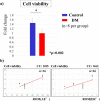Advanced glycation end products are associated with limited range of motion of the shoulder joint in patients with rotator cuff tears associated with diabetes mellitus
- PMID: 35317765
- PMCID: PMC8939191
- DOI: 10.1186/s12891-022-05229-5
Advanced glycation end products are associated with limited range of motion of the shoulder joint in patients with rotator cuff tears associated with diabetes mellitus
Abstract
Background: Most degenerative rotator cuff tears (RCTs) are associated with a limited range of motion (ROM) of the shoulder joint. Additionally, patients with diabetes mellitus (DM) show a higher frequency of limited ROM. Recently, advanced glycation end products (AGEs) of proteins have been observed to cause tissue fibrosis, primarily through abnormal collagen cross-linking and oxidative stress. In this study, we investigated the effect of AGEs on ROM limitation in the shoulder capsule and its relationship with DM in the patients with RCTs.
Methods: Sixteen patients (eight in the DM and non-DM groups) who underwent arthroscopic surgery for RCT with limited shoulder ROM were included in this study. AGE-related pathologies in both groups were compared, and the relationship between AGE accumulation and shoulder joint ROM was evaluated. Shoulder capsule tissue was harvested and subjected to histological and in vitro evaluation.
Results: The DM group displayed high levels of AGEs and reactive oxygen species (ROS), and reduced cell viability. There was a significant positive correlation between ROS expression, apoptosis, and preoperative hemoglobin A1c. ROS expression, apoptosis, and ROM of the shoulder joint showed a negative correlation. The NADPH oxidase (NOX) expression and collagen III/I ratio were significantly higher in the DM group than in the non-DM group.
Conclusions: The DM group showed significant AGEs deposition in the shoulder capsule. Additionally, there was a significant association between AGEs and ROM limitation. Collectively, the findings suggest that the oxidative stress induced by AGEs deposition, which leads to fibrosis and local inflammation, might contribute to the limited ROM of the shoulder joint in patients with RCTs accompanied by DM.
Keywords: Advanced glycation end products; Cell viability; Range of motion; Reactive oxygen species; Rotator cuff tears; Shoulder capsule.
© 2022. The Author(s).
Conflict of interest statement
The authors declare that they have no competing interests.
Figures






Similar articles
-
Intra-articular site-specific distribution of advanced glycation end products in the shoulder of patients with diabetes mellitus having rotator cuff tears.Mol Biol Rep. 2023 Dec;50(12):10339-10349. doi: 10.1007/s11033-023-08861-z. Epub 2023 Nov 20. Mol Biol Rep. 2023. PMID: 37982930
-
Advanced glycation end products in idiopathic frozen shoulders.J Shoulder Elbow Surg. 2016 Jun;25(6):981-8. doi: 10.1016/j.jse.2015.10.015. Epub 2016 Jan 5. J Shoulder Elbow Surg. 2016. PMID: 26776943 Free PMC article.
-
Biochemical Markers of Aging (Advanced Glycation End Products) and Degeneration Are Increased in Type 3 Rotator Cuff Tendon Stumps With Increased Signal Intensity Changes on MRI.Am J Sports Med. 2022 Jun;50(7):1960-1970. doi: 10.1177/03635465221090649. Epub 2022 Apr 29. Am J Sports Med. 2022. PMID: 35486520
-
Does Distal Clavicle Resection Decrease Pain or Improve Shoulder Function in Patients With Acromioclavicular Joint Arthritis and Rotator Cuff Tears? A Meta-analysis.Clin Orthop Relat Res. 2018 Dec;476(12):2402-2414. doi: 10.1097/CORR.0000000000000424. Clin Orthop Relat Res. 2018. PMID: 30334833 Free PMC article.
-
The Influence of Diabetes Mellitus on Rotator Cuff Repair: A Systematic Review and Meta-Analysis.Comb Chem High Throughput Screen. 2021;24(7):908-920. doi: 10.2174/1386207323666201020114034. Comb Chem High Throughput Screen. 2021. PMID: 33081680
Cited by
-
Arthroscopic Repair of Rotator Cuff Tears Using a Suture Hook With Lasso Loop for Forward Suture Passing.Arthrosc Tech. 2024 Jan 1;13(2):102868. doi: 10.1016/j.eats.2023.10.010. eCollection 2024 Feb. Arthrosc Tech. 2024. PMID: 38435273 Free PMC article.
-
Outcomes of Rotator Cuff Repair: Open vs. Arthroscopic Approaches in Patients with Diabetes or Hyperlipidemia.J Orthop Sports Med. 2025;7(2):240-249. doi: 10.26502/josm.511500201. Epub 2025 May 15. J Orthop Sports Med. 2025. PMID: 40546245 Free PMC article.
-
Shear wave elastography of the supraspinatus tendon with early degeneration in asymptomatic type II diabetes mellitus patients: a multicenter study.BMC Musculoskelet Disord. 2025 Jul 4;26(1):637. doi: 10.1186/s12891-025-08864-w. BMC Musculoskelet Disord. 2025. PMID: 40616074 Free PMC article.
-
A comprehensive analysis of the acromial morphology and etiological factors of partial rotator cuff tears.JSES Int. 2024 Aug 30;9(1):86-90. doi: 10.1016/j.jseint.2024.08.194. eCollection 2025 Jan. JSES Int. 2024. PMID: 39898223 Free PMC article.
-
Basic Science Research in Frozen Shoulder: Current Updates.Indian J Orthop. 2024 Dec 2;59(6):774-784. doi: 10.1007/s43465-024-01294-1. eCollection 2025 Jun. Indian J Orthop. 2024. PMID: 40511347
References
MeSH terms
Substances
LinkOut - more resources
Full Text Sources
Medical

